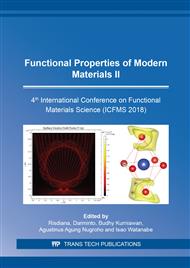[1]
I. Suda, T. Oki, M. Masuda, M. Kobayashi, Y. Nishiba, S. Furuta, Physiological functionality of purple-fleshed sweet potatoes containing anthocyanins and their utilization in foods, JARQ 37 (2003) 167-173.
DOI: 10.6090/jarq.37.167
Google Scholar
[2]
W. Hongzi, L. Jinwei, F. Liuping, Ultrasonically and microwave-assisted extraction of purple sweet potato pigments, J. Anhui Agri. Sci. 38 (2010) 18664-18666.
Google Scholar
[3]
A. Castaneda, L.P Hernandez, E. Paez, J.A. Rodriguez, Chemical studies of anthocyanins: A review, Food Chem. 113 (2009) 859-871.
Google Scholar
[4]
J. Yang, R.L. Gadi, Effects of steaming and dehydration on anthocyanins, antioxidant activity, total phenols and color characteristics of purple-fleshed sweet potatoes (Ipomoea batatas), AJFT 3 (2008) 224-234.
DOI: 10.3923/ajft.2008.224.234
Google Scholar
[5]
D. Tahir, H. Halide, A.W. Wahab, D. Kurniawan, Gamma irradiation effect on the chemical composition and the antioxidant activity of Ipomoea batatas L, AIP Conf. Proc. 1617 (2014) 16-18.
DOI: 10.1063/1.4897093
Google Scholar
[6]
N. Saifuddin, C.W. Wong, A.A.N. Yasumira, Rapid biosynthesis of silver nanoparticles using culture supernatant of bacteria with microwave irradiation, E.J. Chem. 6 (2009) 61-70.
DOI: 10.1155/2009/734264
Google Scholar
[7]
R.J. Giguere, T.L. Bray, S.M. Duncan, G. Majetich, Application of commercial microwave ovens to organic synthesis, Tetra. Lett. 27 (1986) 4945-4948.
DOI: 10.1016/s0040-4039(00)85103-5
Google Scholar
[8]
S.O. Nelson, Potential agricultural application of radio and microwave energy, Transaction of ASAE 30 (1987) 818-822.
Google Scholar
[9]
H.J. Schwarzmaier, T. Kahn, Magnetic resonance imaging of microwave-induced tissue heating, Mag. Res. Medic. 33 (1995) 729-731.
DOI: 10.1002/mrm.1910330519
Google Scholar
[10]
R.S. Kingston, Solvent-free accelerated organic synthesis using microwaves, Pure Appl. Chem. 73 (1997) 193–198.
Google Scholar
[11]
S. Fatimah, Isnaeni, D. Tahir, Assisted surface state recombination of orange peel carbon nanodots in various matrices, Makara J. Sci. 22 (2018) 29-34.
DOI: 10.7454/mss.v22i1.8301
Google Scholar
[12]
R.S. Varma, R. Dahiya, S. Kumar, Clay catalyzed synthesis of imines and enamines under solvent-free conditions using microwave irradiation, Tetra. Lett. 38 (1997) 2039-2042.
DOI: 10.1016/s0040-4039(97)00261-x
Google Scholar
[13]
S.E. Park, D.S. Kim, J.S Chang, W.Y. Kim, Synthesis of MCM-41 using microwave heating with ethylene glycol, Catal. Tod. 44 (1998) 301-308.
DOI: 10.1016/s0920-5861(98)00203-x
Google Scholar
[14]
K. Fuku, R. Hayashi, S. Takakura, T. Kamegawa, K. Mori, H. Yamashita, The synthesis of size and color-controlled silver nanoparticles by using microwave heating and their enhanced catalytic activity by localized surface plasmon resonance, Ang. Chem. 125 (2013) 7594-7598.
DOI: 10.1002/ange.201301652
Google Scholar
[15]
A. Fini, A. Breccia, Chemistry by microwaves, Pure Appl. Chem. 71 (1999) 573-579.
Google Scholar


